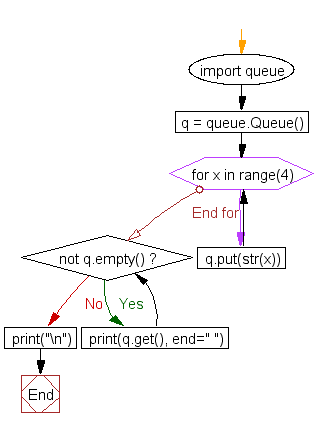

Guarantee that a subsequent call to get() will not block. Similarly, if empty() returns False it doesn’t Returns True it doesn’t guarantee that a subsequent call to put()

Return True if the queue is empty, False otherwise. Guarantee that a subsequent get() will not block, nor will qsize() < maxsize Return the approximate size of the queue. Provide the public methods described below. Queue objects ( Queue, LifoQueue, or PriorityQueue)
PYTHON QUEUE STRUCTURE FULL
Full ¶Įxception raised when non-blocking put() (or Empty ¶Įxception raised when non-blocking get() (or That ignores the data item and only compares the priority number: If the data elements are not comparable, the data can be wrapped in a class A typical pattern forĮntries is a tuple in the form: (priority_number, data). One that would be returned by min(entries)). The lowest valued entries are retrieved first (the lowest valued entry is the Maxsize is less than or equal to zero, the queue size is infinite. maxsize is an integer that sets the upperbound PriorityQueue ( maxsize = 0 ) ¶Ĭonstructor for a priority queue. Insertion willīlock once this size has been reached, until queue items are consumed. Limit on the number of items that can be placed in the queue. The queue module defines the following classes and exceptions: class queue. In exchange for the smaller functionality. Specific implementation provides additional guarantees In addition, the module implements a “simple” Internally, those three types of queues use locks to temporarily blockĬompeting threads however, they are not designed to handle reentrancy The entries are kept sorted (using the heapq module) and the The first retrieved (operating like a stack).

LIFO queue, the most recently added entry is Queue, the first tasks added are the first retrieved. The module implements three types of queue, which differ only in the order in Module implements all the required locking semantics. It is especially useful in threaded programming when information must beĮxchanged safely between multiple threads. If random.The queue module implements multi-producer, multi-consumer queues. # Enqueue or dequeue a bit, with latter having probability of 10%. Return (itm, lst) # Then return item and new list. Lst = lst # Change list to remove first item. Return lst # And return list (for consistency with dequeue). Lst.append(itm) # Just add item to end of list. Were it more serious code, it would be implemented as a class but it should be enough to illustrate the workings: import random
PYTHON QUEUE STRUCTURE CODE
That diagram shows a queue where you've enqueued the numbers 1, 2 and 3 in that order, without yet dequeuing any.īy way of example, here's some Python code that shows a simplistic queue in action, with enqueue and dequeue functions. There are variations of queues such as double-ended ones where you can enqueue and dequeue at either end but the vast majority would be the simpler form: +-+-+-+

You enqueue items at one end and dequeue at the other, just like a line of people queuing up for tickets to the latest Taylor Swift concert (I was originally going to say Billy Joel but that would date me severely). Enqueue and Dequeue tend to be operations on a queue, a data structure that does exactly what it sounds like it does.


 0 kommentar(er)
0 kommentar(er)
